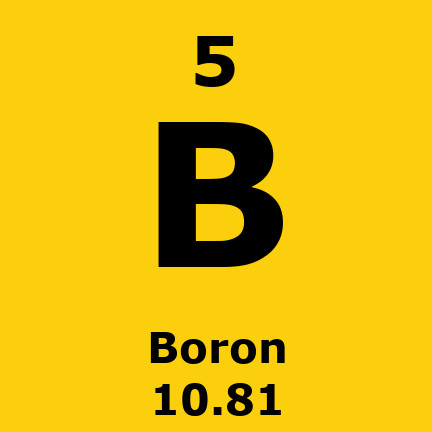Boron (Substance) AKA B

Boron
1808 AD - 1808 AD
AKA B
Produced entirely by cosmic ray spallation and supernovae and not by stellar nucleosynthesis, it is a low-abundance element in the Solar System and in the Earth's crust. It constitutes about 0.001 percent by weight of Earth's crust. Boron is concentrated on Earth by the water-solubility of its more common naturally occurring compounds, the borate minerals. These are mined industrially as evaporites, such as borax and kernite. The largest known boron deposits are in Turkey, the largest producer of boron minerals.
Elemental boron is a metalloid that is found in small amounts in meteoroids but chemically uncombined boron is not otherwise found naturally on Earth. Industrially, very pure boron is produced with difficulty because of refractory contamination by carbon or other elements. Several allotropes of boron exist: amorphous boron is a brown powder; crystalline boron is silvery to black, extremely hard (about 9.5 on the Mohs scale), and a poor electrical conductor at room temperature. The primary use of elemental boron is as boron filaments with applications similar to carbon fibers in some high-strength materials.
Boron is primarily used in chemical compounds:
- About half of all boron consumed globally is an additive in fiberglass for insulation and structural materials.
- The next leading use is in polymers and ceramics in high-strength, lightweight structural and refractory materials. Borosilicate glass is desired for its greater strength and thermal shock resistance than ordinary soda lime glass.
- Boron as sodium perborate is used as a bleach.
- A small amount of boron is used as a dopant in semiconductors, and reagent intermediates in the synthesis of organic fine chemicals.
- A few boron-containing organic pharmaceuticals are used or are in study. Natural boron is composed of two stable isotopes, one of which (boron-10) has a number of uses as a neutron-capturing agent.
- Boron is a component of neodymium magnets (Nd2Fe14B), which are among the strongest type of permanent magnet. These magnets are found in a variety of electromechanical and electronic devices, such as magnetic resonance imaging (MRI) medical imaging systems, in compact and relatively small motors and actuators. As examples, computer HDDs (hard disk drives), CD (compact disk) and DVD (digital versatile disk) players rely on neodymium magnet motors to deliver intense rotary power in a remarkably compact package. In mobile phones 'Neo' magnets provide the magnetic field which allows tiny speakers to deliver appreciable audio power.
The intersection of boron with biology is very small. Consensus on boron as essential for mammalian life is lacking. Borates have low toxicity in mammals (similar to table salt) but are more toxic to arthropods and are occasionally used as insecticides. Boron-containing organic antibiotics are known. Although only traces are required, boron is an essential plant nutrient.








